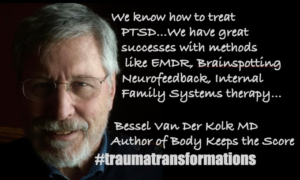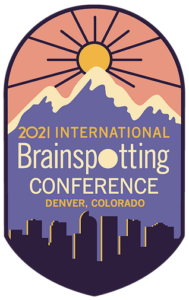Learn more about Brainspotting by clicking each of the questions below:
What is Brainspotting?
Discovered in 2003 by David Grand, PhD., Brainspotting is a powerful Body/Brain therapeutic tool. It works by identifying, processing, and releasing neurophysiologic pain and trauma which has been held in the body and in the brain. Physical trauma influences (and is influenced by) the brain. Emotional trauma influences (and is influenced by) the body. The brain and the body are not separate. The mind and the body are not separate.
Unresolved physical or emotional traumatic events can cause a variety of symptoms from migraines to muscle loss, from depression to a decrease of coordination. All these limitations can have roots in the musculoskeletal tissues themselves, and a major component of those tissues is controlled by the unconscious brain through the autonomic nervous system. This part of our brain is the limbic system and is responsible for the flight or fight response to danger or to a traumatic event.
There is a part of our unconscious brain, an entire system, whose job is to keep us safe. This is called the Limbic System, and it is vital. But, sometimes, in keeping us safe, it causes unwanted effects such as increased pain signals or bracing and guarding muscles.
What is Trauma?
Trauma is any experience which is an assault to our sensibilities. It is very individualized and personal. This personalization explains why one individual who experiences a mugging, for instance, is left quite traumatized while another, in the same situation, is left unfazed.
One key component which changes a threatening event into a traumatic event, is the component of helplessness. If we feel helpless in a dangerous situation, it can become traumatic for us. However, if we are able to have some control and are able to distance ourselves from the danger, the chances of that event becoming traumatic lessen.
Another component that changes a threatening incident into a traumatic one, is who we are the moment before that incident occurs. If we are someone who has experienced multiple traumas in our lives, the chances of the oncoming incident becoming traumatic increase. The inverse is true. If, in our lives, we have had few experiences of being helpless in dangerous situations, we possess more resilience and are able to handle a threatening situation with less lasting effect.
Physical trauma creates a cascade of reactions in the body and in the brain. Emotional trauma creates a surprisingly similar cascade of reactions in the body and in the brain. Regardless of whether the trauma is experienced in the body or experienced emotionally, the end results are experienced in the mind and in the body.
Bracing, apprehension, fear, pain, avoidance – these can all be used to describe both an emotional state and a physical state. When a traumatic event has occurred, these descriptions are often appropriately used to describe our emotions and our bodies. A car accident can leave us apprehensive to drive again but, also, our bodies can demonstrate physical apprehension in the form of decreased range of motion or bracing against movement. The physical injuries to tissues, of course, are there. But, when the normal physiologic window of time for tissue healing has closed, yet there is still pain or decreased motion within our musculoskeletal system, this can be caused by bracing and apprehension within our brain and our unconscious mind. We are not aware of it and cannot control it.
What’s the Difference Between the Mind and the Brain?
The mind is the originator of thought, emotion, planning, personality, imagination, etc. The brain is the physical place where the mind lives. We know this to be true because damage to a specific area of the brain can not only cause physical and functional changes in our body, but it can also simultaneously cause changes in thought, emotion, planning, personality, and imagination in our mind.
Multiple individuals who have experienced injuries to specific areas of the brain all demonstrate the same functional changes in their bodies, and simultaneously demonstrate the same functional changes in their minds. The mind lives in the brain.
Why Would a Physical Therapist use Brainspotting?
Physical Therapy is a deep and broad practice. It is our job and our training to help our patients with movement, strength, pain, flexibility, balance, neurologic function, coordination, proprioception, etc. – so they can return to full function after an injury.
We don’t just look at one component of a loss of function, such as decreased movement, because all these components – and more – are all interrelated and interdependent.
Decreased movement can happen because the muscles aren’t strong enough to create the movement, or the opposing muscles are too tight to allow the movement. It can happen because the joint isn’t aligned correctly or there is pain in the area, or the nerves are not firing enough or are firing too much. Decreased movement can be because of adhesions in the fascia or scar tissue from an old injury, or from apprehension about movement because of a previous injury or emotional trauma.
Physical Therapists can address every one of the components listed above, but if our limbic system (in its effort to keep us safe) still perceives danger, it will override what would otherwise be normal activity and cause us to do something else. Its job is to keep us safe from what it perceives as existing danger. It is our limbic system that tells us if it’s a snake or a stick.
We begin building the database of dangers in our limbic system from birth – perhaps even prebirth. Our limbic system is hardwired to pay attention to anything that is a threat to us. As we move through life, that database becomes larger and larger, and the limbic system does its job better and better. The more trauma(s) it experiences, the more vigilant it becomes.
This would be a tremendous gift were it not for two limitations: the limbic system does not have a sense of time and it does not have a sense of language.
This means, for any danger that we have ever experienced, any trauma that we have ever lived through, the limbic system believes it is currently happening. Therefore, any sensation vaguely similar to an original trauma will set off alarm bells in the limbic system. It will then attempt to convince us to do something other than what we are doing – because its job is to keep us safe.
The lack of language in the limbic system is also significant. This makes recovery from a traumatic event difficult – because telling the story does not inform the limbic system that we have actually survived the event or that the injured tissue is actually healed. Combining this lack of communication with the lack of time-awareness creates an important obstacle in terms of fully recovering from any injury. This is no more obvious than in the face of chronic pain.
I hear similar stories from my patients:
“Yeah, I’ve never been able to turn my head that direction since the car accident.” Or
“Well, it happened when I was 10 and you’d think I’d’ve outgrown it, but I can still feel where that arm was broken 30 years ago.”
“You know, they said it was a minor procedure, but I swear, I’ve never been the same since that surgery.” Or
“Just the sound of a police siren makes my neck tight.”
All of these lasting influences from past traumas still exist because the limbic system Is still trying to protect us from dangers which are no longer present.
This doesn’t mean valuable practices such as physical therapy, talk therapy, acupuncture, medication, massage, meditation, etc., don’t help with chronically involved situations such as chronic pain, fibromyalgia, multiple chemical sensitivity, phantom limb pain, neuralgia, etc. They do! Sometimes, they help significantly.
For those situations in which symptoms last far beyond the normal physiologic time it takes for tissues to heal, we know the limbic system is involved. To fully recover when the improvements stop at 40%, or symptoms go away, but then slowly return, or any of the other situations we find with chronically involved diagnoses, we must involve the limbic system in the healing process. As David Grand, PhD, the Founder of Brainspotting says, “What is in the brain is in the body and what is in the body is in the brain.”
To truly resolve the reactions to – and the lasting influences of – a past traumatic event on our current (and future) life, we must involve the limbic system. Otherwise, we are stuck here between past pain and future fear.
How Does Brainspotting Work?
With careful support by the therapist and precise use of eye position, we access memories around the traumatic event. We bring those stored memories onboard, giving the limbic system the chance to receive new information about that traumatic event in the here-and-now.
In the present time, being with this attentive, empathetic therapist, the limbic system receives new and non-threatening information about the event. This gentle, supportive experience waters down the impact of the trauma. It adds new information to the limbic system – through this current experience of safety around that past traumatic event. Therefore, from now on, any time that memory surfaces, it includes this new, non-threatening information. In an often surprisingly short time the trauma surrounding an event is eased and our patient is left with the memory about the event, but simply a memory – without the trauma.
The result is that our unconscious brain no longer hijacks our movements or our emotions to protect us from a non-existent threat. In fact, this new information provided to the limbic system through Brainspotting shows this part of our brain that the traumatic incident is in the past and it is no longer a current threat. There is no need to brace or guard or avoid movement. There is no need for excessive pain signals to keep us away from danger – because the danger is a memory in the past.
Why is the eye position important?
We naturally use our eye position to access memory all the time. This is very evident when someone asks us to remember something, yet we can’t quite recall it. We have a universal response: our eyes automatically cast about as if there were actually a spot somewhere in the room which would help pull up this memory. When we finally settle on a spot, our eyes go into a soft focus and after a brief moment (if we are lucky) the memory arrives.
On a neurophysiologic basis, the neurologic information from our eyes is directly connected to the limbic system, which is where memory is stored in the brain – including traumatic memory. So, indeed, there actually IS a spot in the room which will help us pull up a memory.
In a Brainspotting session, your therapist may encourage you to let your eyes find that spot on their own or she may help you in finding the spot by having your eyes track a pointer while she carefully moves it. When we find that specific eye position, connected to a specific memory, we call it a Brainspot.
So, by deliberately accessing a physical or emotional traumatic memory in a kind and attuned environment, aided by eye position, we can put new information into our memory banks about that past event. In a surprisingly short number of sessions – much shorter than many other therapies – we can often move beyond previous limitations.
To register for one of our upcoming Brainspotting trainings, click here.
Here are clips from Serene’s interview with David Grand, Ph.D.. You can watch both of her presentations at the 2021 International Brainspotting Conference by purchasing access to the conference recordings here.
Serene and David Grand discussing how to use Brainspotting post-surgically.
Serene and David Grand discussing how the body holds onto trauma and how Brainspotting can be used to release it.



